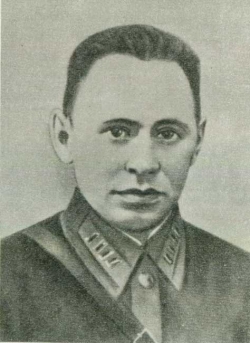
Efim Fomin
Yefim Fomin, a hero of the defense of the Brest Fortress, was born in the shtetl of Kolyshki in the Vitebsk Governorate in 1909, into the family of a blacksmith and a seamstress. After being orphaned at the age of six, Yefim was taken in by relatives. However, they had difficulty feeding another child, and he found himself at an orphanage in Vitebsk shortly thereafter. The prevailing educational philosophy at the time was based on the principles of collectivism, and the practice of raising children at orphanages was encouraged. Fomin began to work at the tender age of 12, first being apprenticed to a barber and later becoming a cobbler's apprentice.
In 1924, while working at a footwear factory in Vitebsk, Yefim Fomin became a member of the Komsomol. His Party career was rather successful. In the 1930, after being drafted into the Red Army, he engaged in propaganda work among the soldiers within the framework of Party mobilization, serving as secretary of the Komsomol organization of an air defense regiment and as the political commissar of a company. In 1938, he completed a course taught by the political administration of the Kharkov Military District, whereupon he was awarded an engraved watch with the inscription "For exceptional achievements in mastering Bolshevism".
Afterward, he was designated military commissar of a Kharkov rifle division.
In September 1939, Yefim Fomin took part in the Red Army invasion of Poland, which led to the annexation of the eastern regions of that country to Soviet Ukraine and Belarus.
In the summer of 1940, Fomin's division was stationed in Daugavpils, Latvia. After being denounced (such denunciations being common at the time), he was reassigned to Brest and demoted to deputy commissar of a smaller unit. Nevertheless, he was able to keep the rank of regimental commissar. (in 1991, the Minister of Defense of the USSR revoked his demotion, restoring him to the rank of divisional commissar).
Shortly before the outbreak of the Soviet-German War, Fomin arrived in the Brest Fortress. This defensive structure, built during the reign of Nicholas I on the site of the old Jewish Quarter in Brest, had been part of the Russian Empire in the 19th Century. After being briefly occupied by Germany during World War I, it was assigned to independent Poland in 1918. In 1939, under the terms of the Molotov-Ribbentrop Pact, the Brest region, including the Fortress, was annexed by the USSR. Furthermore, to mark this annexation, a joint German-Soviet military parade was held in Brest, with Red Army troops and Wehrmacht soldiers taking part. The parade was reviewed by Semyon Krivoshein (see project) from the Soviet side, and by Heinz Guderian from the German one.
The fortress itself, measuring about 4 sq. km, was situated on four islands in the Bug and Mukhavets rivers, and comprised a core citadel on the central island, which was skirted by a ring of barracks. Serving as the western military outpost of the Soviet Union, it had a garrison of about 8000 persons, including the wives and children of the servicemen, and the medical staff.
It was here that the Wehrmacht landed its first, very powerful blow on June 22, 1941.
On the day before the attack, Yefim Fomin was supposed to travel to Daugavpils to bring his family to Brest, but all the train tickets had been sold, and he was forced to return to the Fortress. As fate would have it, Commissar Fomin was one of the few senior offers present in the Brest Fortress at the moment when it came under attack. Early in the morning of June 22, the structure was shelled by German artillery, which damaged the water supply and destroyed the food stores. Because of the surprise, the Fortress was gripped by panic and thrown into disarray. There was a large number of casualties (killed and injured), with many men dying in their sleep or being crushed to death by falling masonry.
Moving under cover of the massive shelling of the Brest Fortress, the elite units of the 45th Austrian Infantry Division were the first to cross the Soviet border. They were able to reach the central section of the Fortress unopposed. Suddenly, Red Army soldiers charged at them from the barracks. These men were led by Commissar Yefim Fomin, who had assumed command. His detachment was able to repel the invaders for a time. However, the Fortress was quickly surrounded. Part of the garrison was taken prisoner by the Germans. Still, the remaining Soviet troops, including the unit commanded by Commissar Fomin, managed to hold some of the Fortress structures. The Red Army men continued to resist the Wehrmacht for a few days, even making a few futile attempts to break out of the encirclement. The beleaguered fortress was shelled by the latest in German siege equipment – the self-propelled Mörser Karl mortars, which left 15-meter-wide craters. The physical assault was accompanied by a massive propaganda offensive, with the soldiers being called upon to surrender.
Yefim Fomin's squad was able to hold the Citadel for a few days, repelling the attackers and even taking a few German POWs. Eventually, however, the exhausted team was overrun. Fomin himself, being both a Jew and a commissar, was shot on the spot, in accordance with the Commissar Order, which instructed the Wehrmacht to execute Soviet political officers and Jewish POWs. The fate of the defenders of the Brest Fortress was tragic: Only a few of them were able to break out and rejoin the Soviet Army, while the rest were either killed or taken prisoner. After the war, many liberated POWs had to endure months-long "filtrations", with large numbers of them landing in the GULAG. Only in 1957 was Yefim Fomin posthumously awarded the Order of Lenin.
Yefim Fomin has been depicted in Soviet and post-Soviet literature and cinema, appearing in Sergey Smirnov's book The Brest Fortress (1964) and in the movies Battle of Moscow (1985) and Fortress of War (2010).
